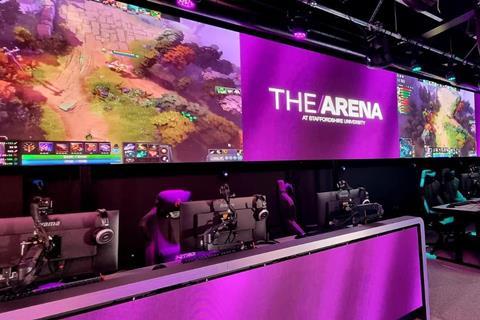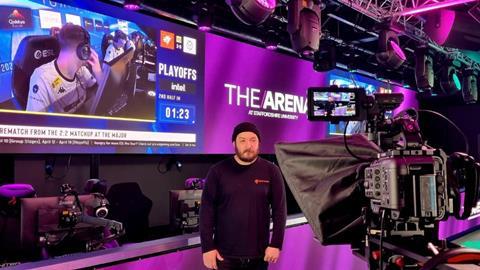IBC365 has kicked off its series of bitesize tutorials, which offer a peek behind the scenes of the industry’s most pressing trends. Part 1 introduced speakers from Staffordshire University’s £2.9 million expanded esports provision discussing the growth of esports, the future potential for broadcast solutions and the cutting-edge technology used in the University’s brand-new arena.
The university, which has been running esports courses since 2015, approached Digital Garage to plan out the building of the facility, a build that included installing a Panasonic Kairos vision mixer and SMPTE 2110 for video to enable flexible, multi-purpose use of the facilities.

Esports Episode 1: Where are we now?
Episode 1 runs through the timeline from where it all began to the current climate and “who is watching”, from LAN parties and ‘clan’ formation, to world-class stadium events and how esports are now colliding with other broadcast media.
“Esports today is a place that has huge attention, audiences and prize pools,” says Phil Cooke, Esports Lecturer at Staffordshire University, emphasising the rapid progression esports has seen, such as Dota’s ‘The International’ which featured a $40 million prize pool in 2021.
Cooke notes that thanks to broadcast technology, esports has gained international audiences, as well as consumer opportunities, resulting in tiered structures of events and investment. “The quick legitimisation of the esports industry and escalation of scale in the events has meant that production teams have had to be quick to the mark to ensure that they match up to the expectations of a demanding audience.”
Esports Episode 2: Production
In episode 2: Esports Production, Joshua Wales-Ferguson, Lecturer in Esports Broadcast Technology tells IBC365 that the university previously worked within a “remote production set up using new tech equipment and fully NDI, which was good for a lot of purposes but we wanted to give the students a real life experience of what it would be like to work in an esports production, both in the atmosphere and experience we can give them in an arena… as well as the production know-how that goes with that, such as replay operation with the EVS and the networks that we use in here.”

Digital Garage, a provider of technical broadcast business solutions, managed the build of the facilities, installing and configuring the final technical kit and technical training. Tom Gill, Technical Services Engineer, talks of the most cutting-edge feature being the audio and video over IP, with the aim to give “ultimate flexible, futureproofing and the students the best experience of what they might find in the esports industry in the real world.”
“Esports in its very nature is cutting-edge and new and sort of marking the future of TV production,” Gill comments.
Esports Episode 3: Audiences and future of esports
Episode 3 covers the audiences and the future of esports, with Rhys Williams, Esports Lecturer at Staffordshire University diving into the commercial benefit that the hype around esports offers broadcasters and why broadcast needs to be on point.
Explaining why broadcast is going to be increasingly important for esports he says: “A single esports tournament can be broadcast across the globe within minutes.”
He shares how to run a broadcast and what broadcasters need to consider, including accessibility and representation – one of the biggest hurdles for broadcasting esports at the moment.
As communities and fanbases continue to grow across the globe, so do the opportunities for broadcast convergence and monetisation. Now is the time to capture audiences, in one of the most rapidly growing areas of content.
Watch Now ESPORTS EPISODE 1: WHERE ARE WE NOW?
























No comments yet